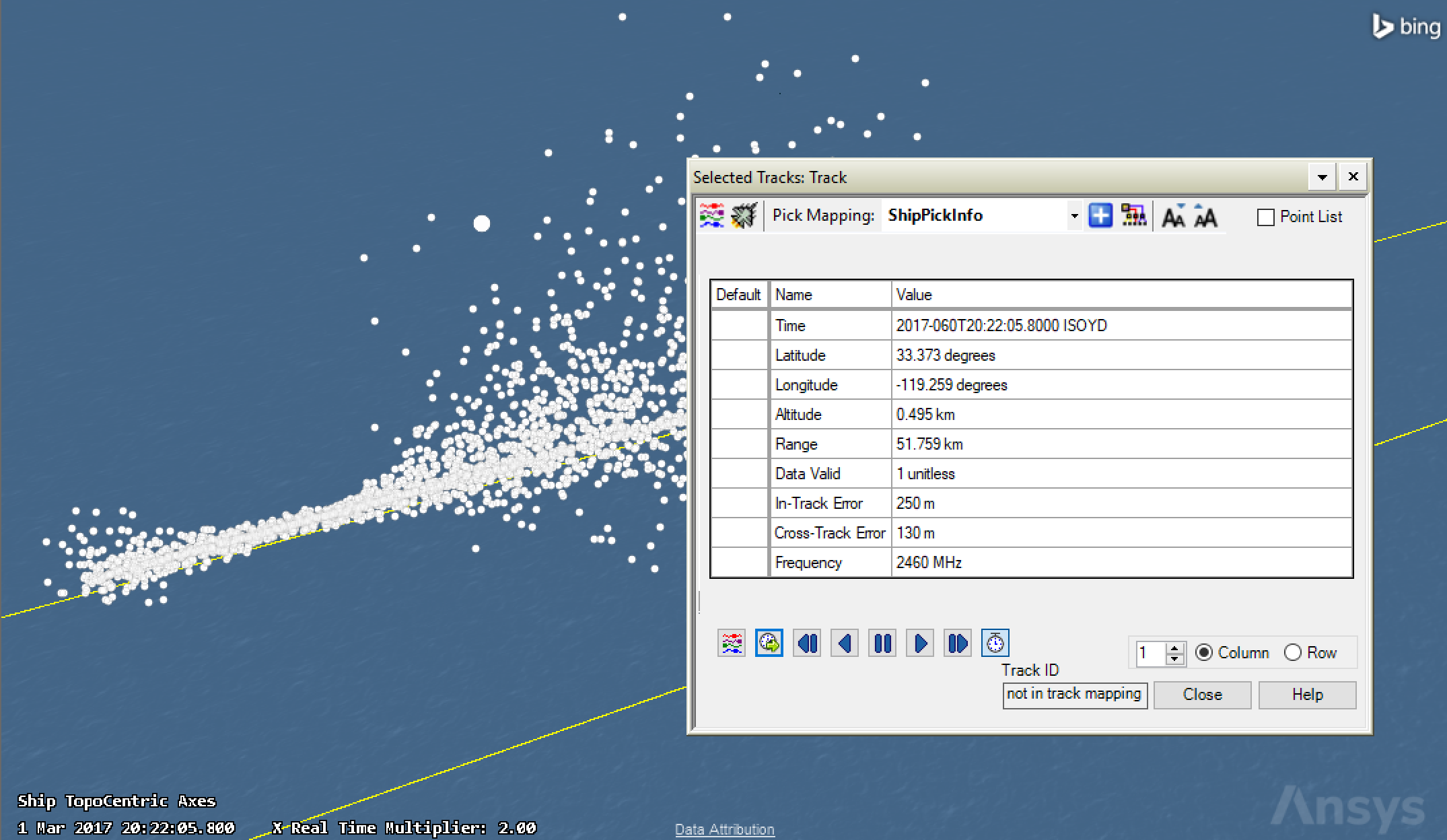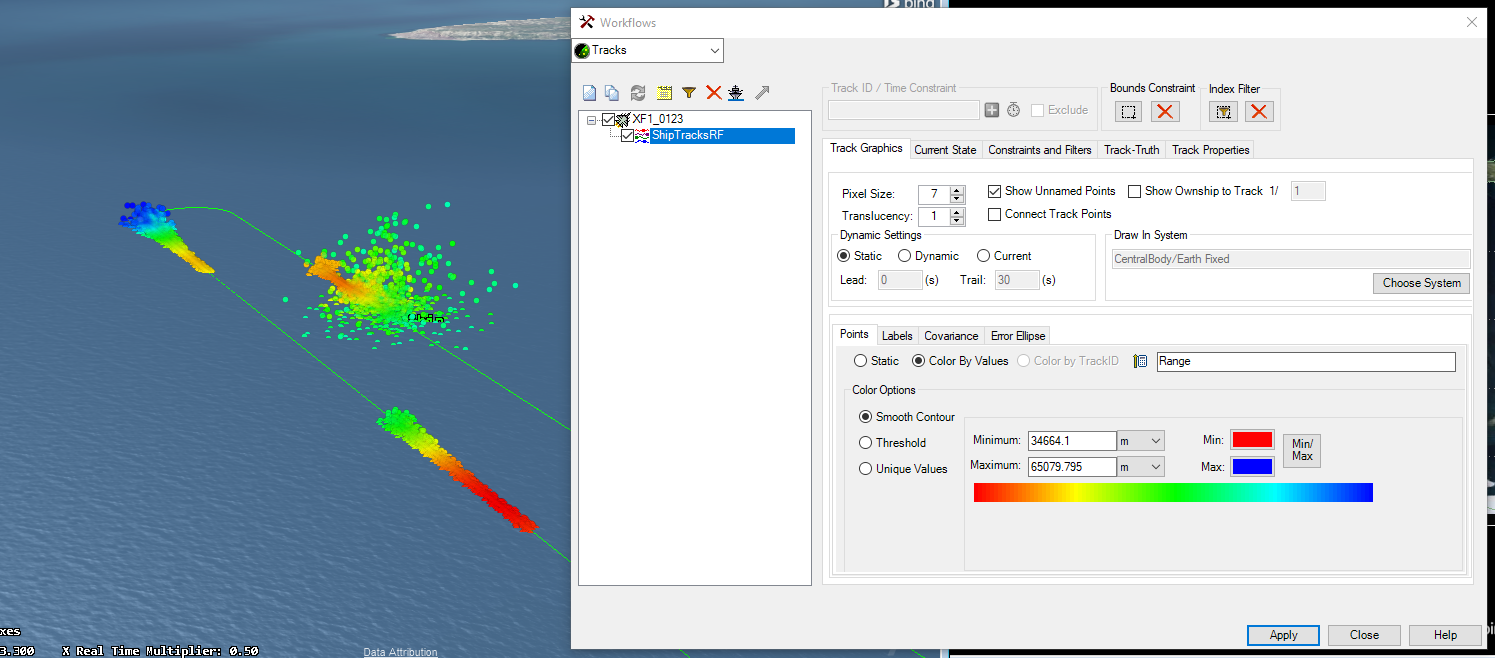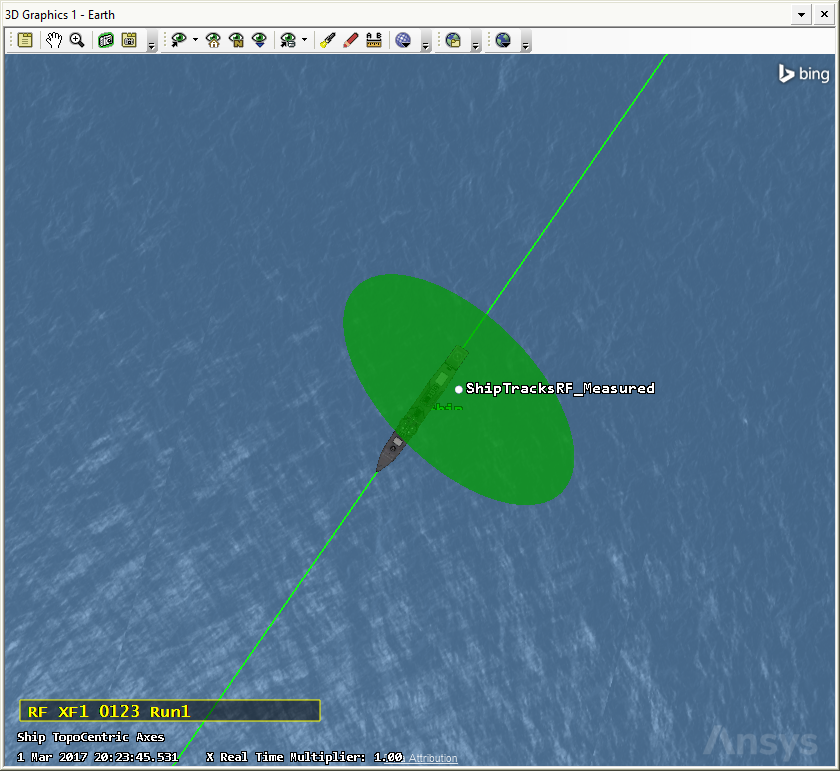STK Enterprise
You can obtain the necessary licenses for this tutorial by contacting AGI Support at support@agi.com or 1-800-924-7244.
Capabilities covered
- Test and Evaluation Tool Kit (TETK)
- STK Pro
Configuring the 3D Graphics window
Configure the 3D Graphics window for the Tracks Workflow.
- Click the Flight Segment Definition (
 ) button in the Test and Evaluation Tool Kit toolbar.
) button in the Test and Evaluation Tool Kit toolbar. - Toggle on the RF and RADAR check boxes.
- Click the Flight Segment Control (
 ) button in the Test and Evaluation Tool Kit toolbar.
) button in the Test and Evaluation Tool Kit toolbar. - Turn on all the SubSystems (RF and RADAR) by clicking the On/Off buttons for each run's segments.
- Close the Flight Segment Control window.
- In the Flight Analysis Tool, clear all check boxes that are currently enabled.
- In the Object Browser, toggle on the Ship check box.
Creating ship tracks
The Ansys Test and Evaluation Tool Kit (TETK)™ capability has the ability to load in track measurement data for display in the 3D Graphics window and can also be used in several analytical workflows. You will now load sample RF measurement tracks by the ownship against the ship.
- Click the Data Importer (
 ) button in the Test and Evaluation Tool Kit toolbar.
) button in the Test and Evaluation Tool Kit toolbar. - Click and browse to C:\Program Files\AGI\STK_ODTK 13\Help\STK\TeTraining\Training files. Open the Ship Tracks - RF.csv file. This contains the time, latitude, longitude, altitude, and range of each track as well as the validity of the track and the in-track/cross-track errors.
- Under the Data Reader Properties section, select Time from the drop-down list for Time Column.
You don’t yet have a data time mapping for an element called “Time” which is why it’s not auto-selected.
- Click in the Select Analysis Object window.
- A window displays for creating a new time mapping for "Time." Set the Mapping Name to Time and click .
- Click at the data import success.
Though the mapping name does not matter at this time, it will be more organized if you set it to match the time element name.
Creating a set of measurement points from the data
When importing data as Additional Data, you’re just creating a pointer (reference) to the data file and the data elements it contains. Next, you will exercise the TETK Tracks Workflow to create a set of measurement points from the data.
- Open the Custom Workflow (
 ) from the Test and Evaluation Tool Kit toolbar.
) from the Test and Evaluation Tool Kit toolbar. - Select Tracks from the drop-down and create a new track (
 ).
). - Set the Track Name to ShipTracksRF.
- Set the Track Promotion Type to Ship.
- In the Track Mapping section, click the plus button (
 ) to create a new mapping.
) to create a new mapping. - Set the Track Mapping Name to ShipTracks.
- Expand Ship Tracks - RF.csv and move Time, Latitude, Longitude, Altitude, and Data Valid over to the appropriate properties.
- Despite the altitude data element not having "MSL" in the name, keep the altitude reference set to MSL.
- Click the Error Ellipse (Optional) tab and assign the In-Track Error and Cross-Track Error to the appropriate properties.
- Click .
- In the Pick Info Data Group section, click the plus button (
 ).
). - Set the Pick Info Mapping Name to ShipPickInfo.
- Move all items under Ship Tracks - RF.csv to the Selected Data Elements table under the Default folder.
- Click , then click again to close the Track Setup panel.
Using the Tracks Pick window
- Zoom-To the Ship object and you can see all the static measured tracks.
- Double-click on any measured track point and you will see all the data associated with that track point.
- Click the clock button (
 ) to set and sync the scenario animation time with the currently selected track point.
) to set and sync the scenario animation time with the currently selected track point. - Use the animation controls or WASD hotkeys to step through the scenario along the measured tracks points.
- Close the Tracks Pick window.
- In the Custom Workflows window, under the Track Graphics tab > Points sub-tab, select the Color By Values radio button.
- Click the data element button (
 ).
). - Expand Ship Tracks - RF.csv and choose Range.
- Click the button and click at the popup.
- Click .
- Save your scenario.

The points will now be colorized based on the range from the ownship.

Understanding the Track Comparisons workflow
In the RF runs, you are assuming there are emitters from the Ship target. Ownship is trying to detect these emitters, and the measured tracks that you imported last section represent these detections. This is how you can analyze how close the detections were to the actual ship location with a certain in-track and cross-track error. You can also confirm if the frequency detected was the frequency at which the ship emitters were transmitting. The Track Comparison workflow will take the measured track data and compare it to the truth data, which in this case is represented by the ship's TSPI data.
- In the Custom Workflows window, select the Tracks workflow option, then ShipTracksRF.
- Under the Tracks Graphics Tab > Dynamic Settings, select the Current radio button.
- Click .
- In the Custom Workflows window, select the TrackComparison workflow option from the drop-down and create a new comparison setup (
 ).
). - Set the Track field to ShipTracksRF.
- Click when asked to promote the object.
- The Name text box is filled automatically. You can edit the Name if you choose.
- Confirm that the Ownship shows XF1_0123.
- Under Truth Object, click the plus button (
 ) and choose Ship.
) and choose Ship. - Under Calculation Settings in the Data Reference Frame field, click the frame button (
 ) and choose XF1_0123 NorthWestUp.
) and choose XF1_0123 NorthWestUp. - In the Distance Error Reference Frame field, choose the same frame that was used for the Data Reference Frame.
- Select the Include Covariance and Error Ellipse checkbox.
- Click . This calculation may take a few moments.
- After calculations are complete, select the TC_ShipTracksRF in the Track Comparison panel and click the Track Comparison Results Calculator button (
 ).
). - Close the Results Calculator.
- Zoom-to the ownship XF1_0123 object.
- In the Workflows window, try toggling on some of the parameters (To_Ship, To_ShipTracksRF_Measured, etc.). You’ll see the appropriate 3D component turn on attached to the ownship object.
- Zoom-to the Ship object.
- Select the Tracks workflow option and click the ShipTracksRF.
- Under the Track Customization, click the Error Ellipse sub-tab.
- Select the Show Error Ellipse check box and verify that the Use Comparison Colors check box is checked.
- Click .
- Save your scenario.
This means the track will be converted to a heavy STK object so it is possible to perform analysis against other STK objects (i.e. aircraft or ship objects). The initial ShipTracksRF object is what’s known as a Measurement Track Object (MTO) and is purpose built to excel at visualization of points in 3D space. The promoted object appears in the Object Browser as "ShipTracksRF_Measured" and in this case is a ship object due to inputting “ship” as the track promotion type when ShipTracksRF was created in the Tracks workflow.
The Measured Object, ShipTracksRF_Measured, was selected automatically after the track selection was made.
This shows calculated information from the Ownship to the Ship target. The top of the window enables you to filter data by certain evaluation parametrics and the bottom of the window shows the associated measures of performance. In the left panel, you can export the time-dynamic measure of performance values as a *.csv ( ), create a graph (
), create a graph (![]() ), and create a data display (
), and create a data display ( ), among other options.
), among other options.
If you zoom in to the ship and animate, you will see the error ellipse based on the in-track and cross-track error values shown at each measured track point. (You may need to zoom in/out a bit to see the error ellipse.) If the ellipse is green, that means the ship falls within the error ellipse. If the ellipse is red, that means the ship is outside the error ellipse.
